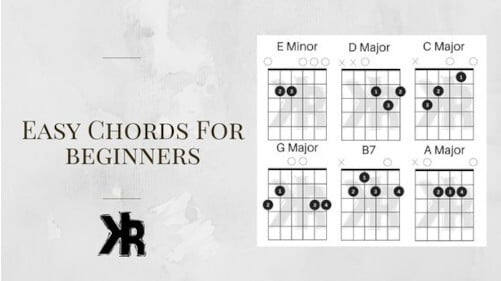Table of Contents
Whether you’re here because you’ve always wanted to play your favorite song, or you’re just itching to pick up a new hobby, you’ve come to the right place.
Welcome to the fascinating world of guitar playing, and more specifically, to a place where we break down the building blocks of any song you’ve ever heard, the chords.
Learning to play the guitar can be a bit daunting at first. All those strings and frets can seem like a maze.
But don’t worry, I’m going to teach you a new way of looking at them. Together, we’re going to demystify this beautiful instrument and get you strumming in no time.
Easiest Guitar Chords for Beginners
Here are the easiest guitar chords a beginner can learn right away:
| Chord Name | Key Notes | Sounds Like |
|---|---|---|
| C Major | C, E, G | Bright & Cheerful |
| G Major | G, B, D | Uplifting & Strong |
| E Minor | E, G, B | Deep & Melancholic |
| A Minor 7 | A, C, E, G | Soft & Soulful |
Chords are the heart of most songs, and understanding them is key to becoming a great player. But there is a right and wrong way to going about learning them. Today, I will teach you how to get started.
We’ll explore everything from how to read chord diagrams to playing your first major and minor chords.
And, of course, I’ll be sharing some of my favorite tips and tricks to help you along the way. Which, in my opinion, is much easier than what others are teaching today.
So, grab your guitar, find a comfy seat, and let’s get started! It’s time to make some music.
Understanding the Basics
The first step to mastering the guitar is understanding its language. If you are an absolute beginner, then you will need to take musical theory step-by-step. This will make it much easier for anyone to understand, and is how I direct my students.
On that note, let’s get into some guitar fundamentals that’ll make the rest of your journey smoother.
How to Read Guitar Chord Diagrams
Chord diagrams are like a roadmap for your fingers, showing you exactly where to place them on the fretboard.
They might look a bit alien at first, but once you get the hang of them, they’ll be your best friend. And you don’t need to be proficient in musical notation at the start.
A chord diagram typically shows six vertical lines and five horizontal ones. The vertical lines represent the six strings of your guitar, with the leftmost line being the lowest or 6th.
The horizontal lines represent the frets. Each dot on the diagram shows where you should place your fingers, and the numbers indicate which finger to use.
Major and minor chord diagrams follow the same logic. The only difference will be how they are played.
Types of Guitar Chords
There are many types of chords as part of musical phrasing, but as a beginner, you’ll primarily be focusing on two kinds: major and minor.
Major vs. Minor Guitar Chords
Major chords sound bright and happy, while minor chords have a more somber tone. The difference between them is one single note, but this small change can significantly affect the mood of a song.
Tips for Playing Your First Guitar Chords
Let’s get you started with some practical tips.
Correct Hand and Finger Placement
Place your fingers on the strings so that when you strum, each string rings out clearly and presents proper intonation. Make sure your thumb is positioned comfortably behind the neck of the guitar, as it’s going to provide the support your fingers need.
Fingerpicking vs Strumming: Two Approaches to Playing Chords
When it comes to playing chords on the guitar, there are generally two techniques that musicians often use: fingerpicking and strumming.
Both methods have their unique characteristics and applications, and understanding the nuances of each can add depth and versatility to your playing.
What is Fingerpicking?
Fingerpicking is a technique where you pluck individual strings with your fingers, as opposed to strumming all the strings at once. This method allows for a more intricate and melodic approach to playing chords.
It’s particularly popular in genres like folk, classical, and blues. Fingerpicking can bring out individual notes within a chord, allowing for more complex musical phrases and a textured sound.
What is Strumming?
Strumming involves sweeping across multiple strings with a pick or your thumb to play a chord. This technique is often used in genres like rock, pop, and country.
Strumming provides a fuller sound and is generally easier for beginners to pick up. It’s excellent for creating rhythmic patterns and is often used to accompany singing.
Pros and Cons
Fingerpicking:
- Pros: Allows for more complex musical arrangements, highlights individual notes, adds texture to music.
- Cons: Generally requires more skill and practice, may not be as effective for all genres.
Strumming:
- Pros: Easier for beginners, provides a fuller sound, excellent for rhythmic accompaniment.
- Cons: Less nuanced than fingerpicking, may not highlight individual notes within a chord as effectively.
When to Use Each Technique
- Fingerpicking: Use this technique when you want to highlight the melody within a chord progression or when playing solo pieces. It’s also effective for genres that require a softer, more nuanced sound.
- Strumming: Opt for strumming when you need a robust, rhythmic foundation for a song, especially in a band setting or when accompanying vocals.
Understanding the differences between fingerpicking and strumming can significantly enhance your musical repertoire.
Getting to Know Your First Chords
Now that we’ve covered the basics, it’s time to get your fingers moving. Let’s take a look at some essential major and minor chords. Remember, every new chord is a new song waiting to be played!
The Major Chords
Major chords are the backbone of countless songs across all genres. Let’s start with two of the most common ones.
C Major Chord
Here’s where your fingers should go for a C Major chord.
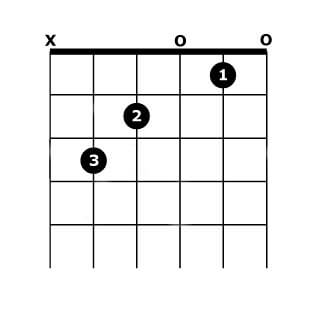
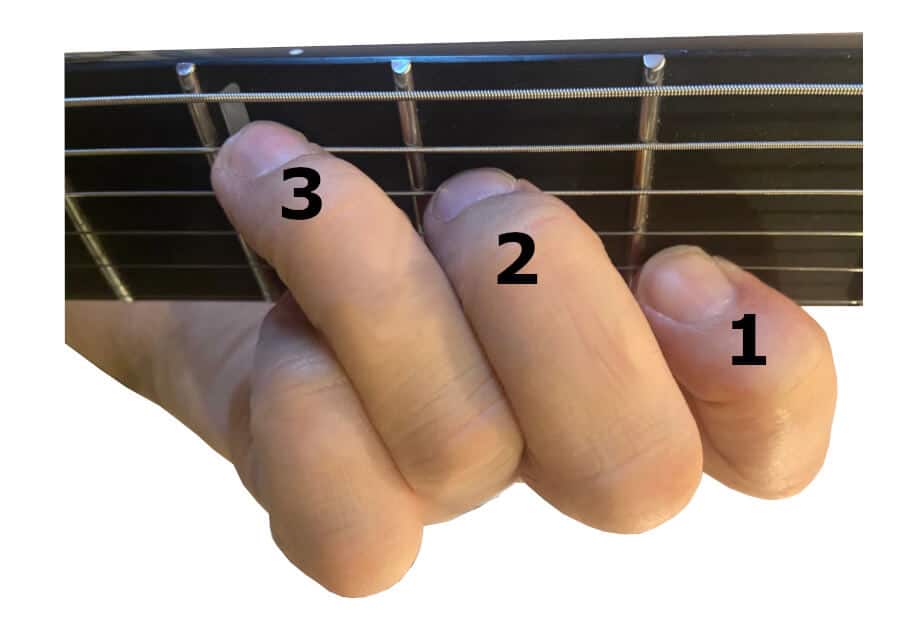
Tips for Playing: Pay close attention to your third finger. It should be on the third fret of the fifth string. Your first finger might find it tricky to press down the second string on the first fret, but keep trying!
G Major Chord
Let’s move on to the G Major chord.
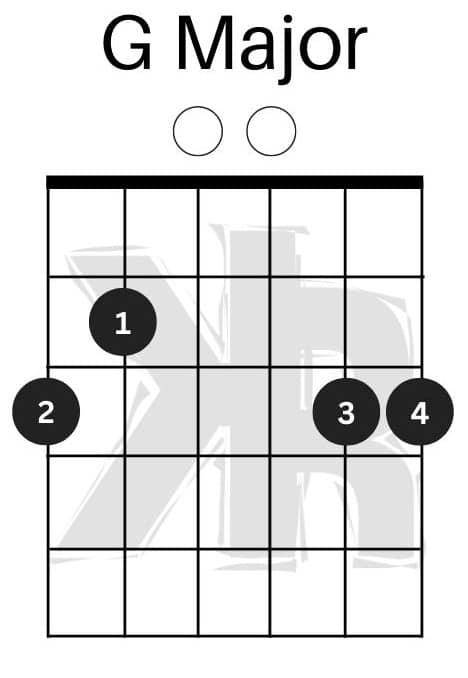
Tips for Playing: This chord uses all six strings when strummed. Ensure your fingers are curved enough so that every string rings out clearly.
The Minor Chords
Minor chords add depth and complexity to your playing. They might be a bit trickier, but they’re worth the effort.
E Minor Chord
Ready for a challenge? Here’s the E Minor chord.

Tips for Playing: This chord involves using your second and third fingers. Don’t get discouraged if you can’t get it right away. It takes time to build up the necessary finger strength.
A Minor 7 Chord
Now, for the last chord of the day, the A Minor 7. There is a note added to the root chord, creating a triad.
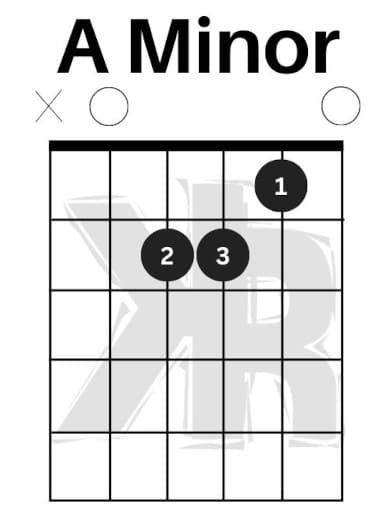
Tips for Playing: This one’s a bit easier and very versatile. Make sure your fingers are pressing down the strings firmly enough to get a clear sound.
Remember, learning to play chords is a lot like learning to ride a bike. You might wobble at first, but with practice, you’ll be cruising along in no time. Be patient with yourself, and above all, enjoy the journey!
Memorizing Chords
Knowing the chords is one thing, but being able to recall and play them at a moment’s notice is another. This is where memorization comes in.
Repetition Is Key
Repetition is the mother of learning. Practice shifting from one chord to another until your fingers know where to go without you having to think about it.
Visualize
When you’re away from your guitar, visualize the chord shapes and your fingers playing them. This mental practice can be surprisingly effective!
Play Songs
One of the best ways to memorize chords is to use them in songs and compositions. Start with simple songs that use the chords you’re learning.
Chord Progressions
In the realm of music, chord progressions serve as the structural foundation upon which songs are built. These sequences of chords create the harmonic landscape of a piece, guiding its emotional and sonic direction.
This topic is a bit more advanced for someone completely new to chords, but it will help to at least introduce the concept. Especially if you intend to play songs.
What Are Chord Progressions?
A chord progression is a series of chords played in a specific order. These progressions can be simple, involving just a few chords, or complex, with intricate arrangements that include various chord extensions and alterations.
The choice of chords and their sequence can evoke different emotions, making them a powerful tool in a musician’s arsenal.
Popular Chord Progressions
- I-IV-V: Often found in blues, rock, and country, this progression is straightforward yet effective. For example, in the key of C, the chords would be C (I), F (IV), and G (V).
- ii-V-I: A staple in jazz music, this progression provides a sense of resolution and is often used at the end of phrases. In the key of C, the chords would be Dm (ii), G (V), and C (I).
- I-V-vi-IV: This is a popular progression in modern pop music, known for its catchy and uplifting feel. In the key of C, it would involve the chords C (I), G (V), Am (vi), and F (IV).
Why They Matter
Chord progressions are the backbone of almost every song you’ll encounter. They dictate the song’s mood, serve as a canvas for melodies, and offer a harmonic framework that both musicians and listeners can connect with.
Mastering the art of chord progressions can elevate your musical capabilities, allowing you to create more engaging and emotionally resonant compositions.
Common Mistakes and How to Avoid Them
Proper technique is essential, not just for sounding good, but also for ensuring your hands and fingers stay healthy.
Bad habits might not cause problems right away, but they can lead to strain or injury down the line. It’s easier to learn the right way now than to try and fix bad habits later.
Pressing Too Hard
One common mistake beginners tend to make is pressing the strings too hard. This not only tires your hand quickly, but can also make the strings sound out of tune. The trick is to apply just the right amount of pressure to make the strings resonate clearly.
Incorrect Thumb Position
Next, let’s talk about thumb position. Your thumb should rest comfortably against the back of the guitar neck. If you notice your thumb creeping over the top of the fretboard, it’s time to readjust your grip.
Muting Adjacent Strings
Lastly, be careful not to accidentally mute the adjacent strings with your fingers. This happens when your fingers lie too flat against the fretboard. To avoid this, ensure your fingers are properly curved, using just the tips to press down on the strings.
Conclusion
Working on these chords with a great learning plan will train your fingers and muscle memory. They are very easy, and after a few months should be simple to perform by memory.
And because they are part of many easy guitar songs, they are a great inspiration to keep pushing forward. This is a journey, so patience and a solid plan are key. We will do our best to help you with guides, guitar chord charts, and practice tips!
Related Articles
Here are more great articles to help you become a better guitar player:

